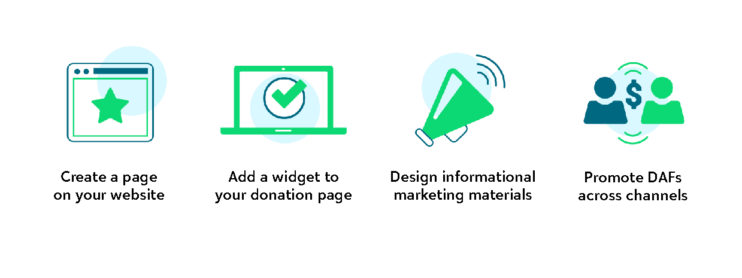Why Are DAFs So Popular? The Appeal of Donor-Advised Funds

Do you feel like you’ve been hearing about donor-advised funds (DAFs) a lot lately? There’s a good reason for it. According to the National Philanthropic Trust’s 2023 DAF Report, donors gave $52.16 billion in DAF grants to nonprofits last year—a 9% increase from the previous year. The total amount of donor contributions to DAFs also grew by 9%, meaning that the rising popularity of donor-advised funds is not slowing down.
However, if you haven’t yet explored donor-advised funds for your nonprofit, you may be wondering what all the fuss is about. Why are DAFs so popular with wealthy donors, and what does this mean for organizations like yours?
In this article, we’ll explore both of these questions by breaking down the appeal of donor-advised funds for both nonprofits and donors. Plus, we’ll discuss how your nonprofit can get started with donor-advised funds if you decide to take the leap. Let’s dive in!
DAFs help donors create a lasting charitable legacy.
The primary purpose of opening a donor-advised fund is to create an avenue for continuous, life-long giving. Once a donor opens a DAF with a public charity, community foundation, or financial organization, they have a dedicated place to set aside funds at any time to give to nonprofits later. Just by opening a DAF, donors demonstrate a commitment to supporting charitable causes long-term.
Plus, just like an endowment, the funding a donor adds to their DAF gets invested by their provider—meaning DAFs have the potential to grow beyond the donor’s initial contributions.
Once the fund has grown, donors can then request that their DAF provider give grants to the nonprofits of their choice at any time. This means that they can create a legacy by giving to multiple organizations throughout their lifetimes, rather than devoting the entire fund to just one. For nonprofits, this also gives you the opportunity to find new DAF-holding donors who are looking for additional organizations to support.
They come with tax incentives.
Beyond the benefits of long-term charitable giving, donors also like DAFs because of the tax incentives they provide. For one, donors can claim tax deductions any time they add money to the account. Even if they don’t grant those funds to a nonprofit yet, they still receive a charitable tax deduction that year.
To understand why this is so appealing to donors, take a look at the following example of what it might look like in practice:
- A donor named Mark contributes $7,000 to his DAF in 2023.
- Mark doesn’t make any grant requests that year, allowing his initial $7,000 to grow instead.
- When he files taxes for 2023, Mark lists his $7,000 DAF contribution and claims his charitable tax deduction for that year.
- In 2025, Mark donates the original $7,000 plus any investment income to the nonprofit of his choice, ultimately giving a larger donation than he would have given in 2023.
Immediate tax deductions aren’t the only benefit—DAFs also have a higher tax deduction limit (60% of a donor’s gross income) than other avenues like private foundations. These tax benefits provide major incentives to open a donor-advised fund, especially for wealthier individuals.
It’s easier to open a DAF than start a private foundation.
The other option for long-term charitable giving for many donors considering opening DAFs is to start a private foundation. Foundations can be started by an individual or family for the purpose of giving grants to organizations working toward a specific cause. However, since a foundation is its own legal entity, opening and running one comes with many more responsibilities than a DAF.
To start a foundation, an individual must register it as a trust or nonprofit corporation, form a board of directors, and manage the distribution of grants to nonprofits. Foundations also have to abide by a variety of legal requirements and regulations.
Opening and maintaining a DAF, on the other hand, only requires donors to:
- Choose a DAF provider to open the account with and manage the fund.
- Fill out an application and agree to the DAF provider’s policies.
- Contribute to the fund.
- Request that grants be given to specific organizations.
That’s it! With a DAF, donors don’t have to worry about investing their funds, filing complex legal documents, or distributing the grants themselves. Since the donor only “advises” the fund, they avoid all of the time-consuming responsibilities of the fund’s management.
Nonprofits can easily accept DAF grant donations.
Finally, DAFs don’t have to be a challenge for nonprofits to navigate. With the right tools and marketing strategies, any organization can easily take advantage of this fundraising opportunity to earn large donations and engage high-income donors in the process.
All you have to do is let donors know you accept DAF gifts and make it easy for them to request a DAF grant from their provider. You can do this in a number of ways, including:

Alt text: An infographic explaining how to accept DAF donations, explained in the text below.
- Creating a page on your website about DAFs. Design a web page that explains what DAFs are, why they’re beneficial, and the steps donors should take to request a DAF grant for your nonprofit. Then, link to this page on your “ways to give” page and in any other marketing materials you create.
- Adding a DAF widget to your donation page. You can embed a widget right into your donation page that gives donors all the information they need to request a DAF grant. All they have to do is input the name of their provider, and they’ll be immediately directed to the steps they need to take. To engage as many DAF holders as possible, look for a widget that works with all DAF providers and doesn’t charge a transaction fee for donors.
- Designing informational marketing materials. In addition to the DAF page on your website, you can create social media content, blog posts, or even direct mail appeals that market the option to give via DAF grant and explain how the process works.
- Promoting DAFs across communication channels. Leverage all of your typical marketing channels to get the word out that you accept DAF grants. Then, conduct individual email outreach to donors you think may be interested in donating from or opening a DAF.
Accepting any additional giving option can help you engage donors by letting them give in the ways that make the most sense for them. By taking these steps to accept DAF grants, you’ll show DAF-holding donors that your nonprofit is excited about their commitment to charitable giving and that you want to make the donation process easy for them.
Now that you know the reasons donors and organizations are interested in DAFs, you can start tapping into donor-advised funds for your nonprofit. Lean into these benefits when talking to donors, and you can start earning donations from DAF grants in no time.
